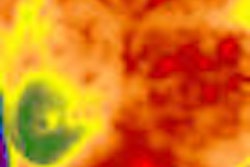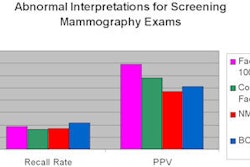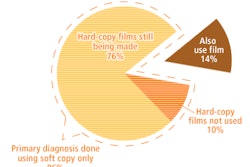The combination of foresight and the hindsight of others can make the process of new technology implementation easier. So when Dr. Barbara Monsees described the issues she discovered when converting to digital mammography, breast imagers sat up and took notice at the Society of Breast Imaging (SBI) postgraduate course held in Colorado Springs, CO, last month.
"Hidden issues are the things you discover even after thinking that you've planned for everything," Monsees, chief of the breast imaging section of Washington University in St. Louis, told attendees.
A team of radiologists, technologists, radiology managers, and IT and PACS staff spent three and a half months intensely planning the mammography service's transition from film to digital, with preliminary planning having begun nine months earlier. An architect, heating/cooling contractors, and electricians also got involved. This teamwork made the transition much easier, but there still were some surprises.
Monsees and colleagues discovered the following hidden issues that you should anticipate.
Display issues
Anticipate how the reading room will change and do a mock-up in advance. While the room will be dark, ergonomics are important. Identify locations of glare from monitors, viewboxes, and even the hallway. Some source of light is needed to move safely around in the space and to see patient folders and paperwork. Figure out what's needed before renovation begins.
If a vendor doesn't offer to demonstrate the different looks of a mammogram on soft-copy displays, ask to see these in advance. A mammogram can be displayed with more or less contrast, as can spot images and when a magnification tool is utilized.
The radiologists who interpret mammograms need to reach a consensus, because this setting is made at the acquisition workstation. It is more efficient to agree upon these settings in advance.
Have your vendor retain records of all display settings, because when the software is upgraded, it is likely that displays will return to default settings. Have the PACS manager verify that these are properly reset before the service representative leaves your premises, Monsees advised.
Applications specialists will work with individual radiologists to define and set up customized viewing protocols. It's possible to have different display protocols based on type of exam.
Learn how to change viewing protocols and write down the steps to do so -- don't rely on memory. Many radiologists want to modify their individual protocols once they've become familiar with reading digital mammograms. The PACS administrator may not be able to do this for you, and it may be weeks before the vendor's application specialist is scheduled to visit.
Learning curve and workflow slowdown
It's important to be aware of digital mammography's learning curve. Reading time may double, and it may take longer than 90 days to adjust. Be prepared for callback and biopsy rates to increase. The first year is the worst, in spite of your preparation, Monsees advised.
It may be necessary to modify patient scheduling for several months to enable radiologists to adjust without feeling overly pressured.
Technologists may be able to nearly double the number of screening mammograms in the time it took to perform analog ones. At Washington University, staff chose to maintain the same number of screening mammography appointments rather than increase throughput. The technologists are instructed to spend more time with the patient and are responsible for taking the patient's history. More clinically important information is obtained, according to Monsees, and patients like the additional time spent with them as well.
Mammographer/technologist interaction
Use the annotation tools liberally on screening mammograms that require patient recall. Technologists need to see the areas of concern when they reimage the patient. Electronic mark-up can be easy to overlook during the learning period.
For diagnostic screenings, determine the best way for technologists to efficiently communicate with you based on your software and your culture. Face-to-face communication may still be best, and because of the interruptions, this may be the time to read diagnostic exams.
It is imperative to have a patient's complete file in advance of a diagnostic exam. To render an immediate opinion on a new visit, prior mammograms and other images must be available. If not, they need to be rescheduled. If film, these can either be viewed on a viewbox or digitized.
Monsees recommends that these patient files be available in the order of appointment unless all the contents are available in their digital file. To increase radiologist efficiency, each file should be chronologically organized by the technologist assistant in advance. If any prior studies need to be manually retrieved from the PACS or archival storage, this should also be done in advance by the tech assistant. Avoid unnecessary image retrieval delays.
Where is everybody?
If your facility has software that tracks staff and patients, you're lucky. But if you don't, invest in a glow-in-the-dark manual whiteboard, or an electronic version. It's important to know where the clinical staff is working, and where the nonscreening patients are.
A "choreographer" technologist whose job is to keep track of patients is worth his or her weight in gold, according to Monsees. It is this person's responsibility to keep track of patients and their progress in the department -- who is getting a diagnostic mammogram, who is in the ultrasound room, if a patient is in the consultation room, and so on. This person also manages biopsy specimens.
The choreographer is responsible for releasing a patient, keeping the status board up-to-date, and identifying scheduling delays and no-shows.
Batch-reading screening mammograms
The two most effective ways to regain interpretation speed is to read screening mammograms in batches and to use a scribe, according to Monsees.
She reads screening mammograms in batches of 30. When digital mammography was first implemented at Washington University in 2006, all of these had analog film priors, and a tech assistant would hang films on the viewbox. After the first 12 months of implementation, patients would be batched depending upon whether their immediate prior was in the system. If it was not, these patients would be subgrouped into those who had digitized films, those who had images on DICOM CD imported into the system, and those who had film.
When viewboxes were phased out after two years, it became the responsibility of support staff to digitize images and scan written information into the patient's electronic file in advance.
The value of scribes
Scribes replaced mammography interpretation checklists; Monsees told AuntMinnie.com that the idea of using a scribe occurred when brainstorming how radiologists could efficiently use a mouse, keyboard, dictation microphone, paper checklists, and pens.
Susan Kraenzle, the breast center manager, suggested that a scribe replace pen and paper. Film library support staff evolved into scribe/data managers, and these individuals join radiologists when they are reading batches of screening mammograms. The scribe opens the patient's chart and manually inputs the items on the checklist as they are called out by the radiologist. Macros have been developed for all normal reports and standard abnormal findings.
"This makes the process so much faster. I never take my eyes off the images," Monsees said. For Kraenzle, everything is done in real-time. Nothing is ever misplaced.
By Cynthia E. Keen
AuntMinnie.com staff writer
June 4, 2009
Related Reading
Digital mammography transition: The agony and the ecstasy, May 5, 2009
Mammography as an outpatient revenue generator? You bet, April 9, 2009
Digital mammograms take longer to read, study suggests, January 6, 2009
Digital mammography more cost effective than analog, report says, September 11, 2008
Copyright © 2009 AuntMinnie.com



















